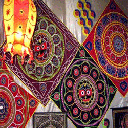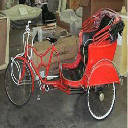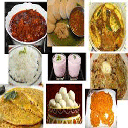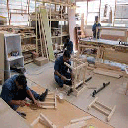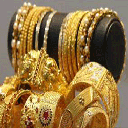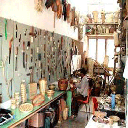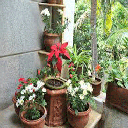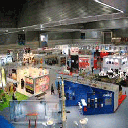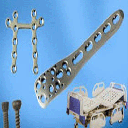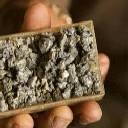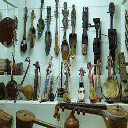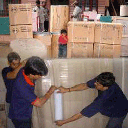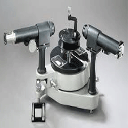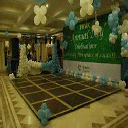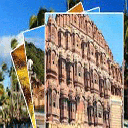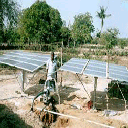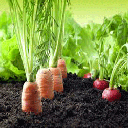Punjab is located in northwestern India, and has an area of 50,362 km2. It extends from the latitudes 29.30° North to 32.32° North and longitudes 73.55° East to 76.50° East. It is bounded on the west by Pakistan, on the north by Jammu and Kashmir, on the northeast by Himachal Pradesh and on the south by Haryana and Rajasthan. Most of the Punjab lies in a fertile plain, alluvial plain with many rivers and an extensive irrigation canal system. A belt of undulating hills extends along the northeastern part of the state at the foot of the Himalayas. Its average elevation is 300 meters above sea level, with a range from 180 meters in the southwest to more than 500 meters around the northeast border. The southwest of the state is semi-arid, eventually merging into the Thar Desert. The Siwalik Hills extends along the northeastern part of the state at the foot of the Himalayas. The soil characteristics are influenced to a limited extent by the topography, vegetation and parent rock. The variation in soil profile characteristics are much more pronounced because of the regional climatic differences. Products Of agricultural products, sugercan is grown everywhere in the fertile tracts and indigo in the low southern regions, borth being largely exported towards Sindh and Kabul. Cotton is produced and exported in large quantities. Wheat and maize are extensively cultivated. The other articles of produce are buckwheat, rice, barley, millet; oil-seeds, such as sesamum and mustard, various sorts of vetches, carrots, pease, beans, onions, turnips, cucubmbers, and melons. Extensive irrigation is carried on by means of canals and the Persian wheel is employed to draw water from the wells. Wheat, gram and barley are grown in the spring, and Indian corn, rice, cotton, pulses, indigo, and sugercane is the autumn. Wheat is largely produced in the divisions of Lahore, Amritsar, Jalandhar, and Rawalpindi. The largest areas under cotton cultivation are found in the districts of Lahore, Ambala, Gurgaon and Rawalpindi. The chief sugar producing districts are Sialkot, Gurdaspur, Jalandhar, Hoshiapur, and Ambala. Indigo is almost entirely confined to the districts of Multan, Mozaffargarh and Dera Ghazi Khan. Tea is grown in the hill tracts of Simla and Kangra. Punjab is divided into three distinct regions on the basis of soil types; southwestern, central, and eastern. Punjab's climate is characterized by extreme hot and extreme cold conditions. Annual temperatures in Punjab range from –2 to 40 °C (min/max), but can reach 47 °C (117 °F) in summer and –4 °C in winter. Sikhism is the predominant faith in Punjab. About 60% of the people in the state are Sikhs. The holiest of Sikh shrines, the Sri Harmandir Sahib (or Golden Temple), is in the city of Amritsar. The Sri Akal Takht Sahib which resides within the Golden temple complex is the temporal seat of Sikhs. Of the five Takhts (Temporal Seats of religious authority) of Sikhism, three are in Punjab. These are Sri Akal Takht Sahib, Damdama Sahib and Anandpur Sahib. Anandpur Sahib is where Guru Gobind Singh created the Khalsa in 1699 on the day of Vaisakhi. During major holidays on the Sikh calendar (such as Vaisakhi, Hola Mohalla, Gurpurb and Diwali), many Sikhs gather and march in religious processions through virtually every city, town and village in Punjab. Sikhism is in fact so common that at least one Sikh Gurdwara can be found in almost every village in the state beside towns and cities (in various architectural styles and sizes). Hinduism is the second most practised faith in Punjab. A large segment of Punjabis who are categorized as punjabi Hindus continue to live out heterogeneous religious practice that includes spiritual kinship with Sikhism. This not only includes veneration of the Sikh Gurus in private practice, but also visits to Sikh Gurdwaras along with hindu temples. The Punjabi language, written in the Gurmukhi script, is the official and most commonly used language in the state. Punjab is served by several institutions of higher education, which provide undergraduate and postgraduate courses in all the major arts, humanities, science, engineering, law, medicine, veterinary science, and business courses. Punjab Agricultural University is a leading institution globally for the study of agriculture, and played a significant role in Punjab's Green Revolution in the 1960s-70s. Among the alumni of the Panjab University, Chandigarh include Manmohan Singh, the current Prime Minister of India, and Har Gobind Khorana, a biochemistry nobel laureate. One of the oldest institutions of higher education is the Christian Medical College, Ludhiana which has existed since 1894
Amritsa Maharaja Ranjit Singh Museum:The museum, named after Maharaja Ranjit Singh, is a treasure house of matchless collection of paintings, arms and armours, manuscript and coins of 18th and 19th Century. This was the summer palace of the king who had brought local chieftains under his control and virtually finished any eventuality of possible attacks on the kingdom raised by him. The palace is situated in a large beautiful garden (Ram Bagh) with a lively statue of Maharaja Ranjit Singh saddled on a horse in a winsome posture. The garden was named by the ruler himself as a tribute to Guru Ram Das. Hari-ke-pattan: Hari-ke-Pattan is a natural serene place famous for its bird sanctuary. It is located on the outskirts of the city, at the confluence of the rivers Beas and Sutlej. Winter (November-onwards) is characterized by migratory birds, coming from as far as Siberia, making it a popular place for bird watching and boating. This is the time when the lake becomes a reception home to nearly 350 species of birds. Hari-ke-Pattan is also one of India's leading in-land sweet water fish market and home of varied wild life. Wagah Border: Wagah is an army outpost on Indo-Pak border, just 9 km from Amritsar city. It is a ceremonial border, where, each evening, armed soldiers from each side of the border pass a particularly hostile parade while lowering their respective flags to the sounding of bugles. The pageant of the beating of the retreat and the change of guard within handshaking distance of the Indian and Pakistani forces here makes the most charming scene at the evening. The ceremony which attracts crowds of spectators from both sides is a poignant reminder of the 1947 when Punjab was divided between two nations. Tarn Taran: This dusty little town situated on the edge of an enormous tank is just 21 km from Amritsar. The tank is believed to have healing properties. A vast flock of migratory birds come to this tank during winters. The site is also famous for several beautiful gurudwaras. Anadpur Sahib Central Fort Sri Anandgarh Sahib: Central Fort Sri Anandgarh Sahib was built in the year 1686. It was hit several times by the combined forces of the hill chiefs and local Moghul officers and every time attackers were put to flight, licking dust. In 1704, however, when the Rajas of Bilaspur, Kangra, Kulu, Mandi, Nurpur, Guler, Chamba, Jammu and Garhwal, in tandem with the Mughal Governors of Delhi, Lahore and Sirhind attacked Anandgarh, although the Fort held out, but for lack of ration and ammunition the inmates were reduced to dire straits. When the besieged Khalsa insisted and the enemy vowed safe passage, the fort was vacated. Since the vows were not kept, the evacuation from the fort spelt disaster in which the 10th Guru's four sons, several intrepid warriors and financial and literary treasures were lost. Lohgarh Fort: It was Sri Anandpur Sahib's Armoury, weapon manufacturing factory and martial training ground. Fatehgarh Fort: Stood guard over the highways which connected Sri Anandpur Sahib to Sirhind and Lahore in the north and to Delhi in the south. Taragarh Fort: Kept watch over the hill states. This fort was built to prevent any attack from the side of the hill State of Bilaspur. Gurudwara Guru-Ka-Mahal (Bhora Sahib): It is the residence of Sri Guru Teg Bahadur inherited by Sri Guru Gobind Singh Ji; the sahibzadas- the holy sons of the 10th Guru were born here. An underground room is there, where the 9th Guru used to meditate. Gurudwara Sis-Ganj Sahib: The martyred head of the 9th Guru which was heroically brought by Bhai Jaita (Bhai Jiwan Singh) after taking holy nectar according to Sikh rites (baptism) in exultant defiance of the Mughal authorities was cremated here, ceremoniously. Gurudwara Damdama Sahib: The 10th Guru was given the Guru Gaddi, here. It was from here that he had declared the end of the institution of the Masands-the priestly agents of the former Gurus. Naina Devi: The hill top shrine of Naina Devi (Mother Goddess) is situated in Bilaspur District of Himachal Pradesh in India. It is just 30 km from Anandpur Sahib and 100 km from Chandigarh. Both Sikhs and Hindus regularly visit each other’s shrines. Since time immemorial, people from all walks of life irrespective of caste ad religion have been visiting this temple for a darshan of Maa Naina Devi. They come with hope to get their wishes fulfilled. Kiratpur Sahib: Kiratpur Sahib is about 10 km from Anandpur Sahib and is a sacred place for all Sikhs. It has a long association with most of the Sikh Gurus. Guru Nanak Dev is said to have visited this place when it was little more than a wilderness. Guru Hargobind, the sixth Guru spent the last few years of his life here. You can see several Gurudwaras here viz. Gurudwara Charan Kamal, Gurudwara Baba Gurditta, Tomb of Baba Buddan Shah, Gurudwara Bavangarh, Gurudwara Pata Puri and Gurudwara Shish Mahal. The significance of this place is that Sikhs immerse the ashes of their dead at this place. Ropar: Ropar or Rupnagar is a small town just 40 km from Anandpur Sahib famous for its museum which houses the findings of Archeological Survey of India (ASI). ASI had excavated treasure troves of remains – in all there were traces of six civilizations. About 15 km from Ropar lies the Gurudwara Parwar Vichhora Sahib, which commemorates the spot where Guru Gobind Singh was separated by his two sons and mother on the night of the battle – 5th December 1705. Holla Mohalla An annual Sikh martial festival, Hola Mohalla is celebrated in the month of Phalguna (March), a day after Holi. The highlight of this fair is a spectacular display of fencing and tent-pegging, as the Nihang Sikhs show off their legendary martial equestrian skills. The festival being an occasion to rejoice is also a time to restore faith in the Khalsa Panth and rededicate oneself to the service of the community. Everyone, irrespective of their social standing, involves themselves in kar seva - manual labour, like helping in the langars, or public kitchens, cleaning the gurudwaras, and washing dishes etc. The festival is celebrated grandly at Anandpur Sahib. Thousands of people visit the shrine to participate in prayers. The symbol of this festival is to understand the duty of an individual with responsibilities towards the society. Ferozepur Anglo Sikh War Memorial This memorial contains portraits of historical personalities, paintings, depicting scenes of battles of the Anglo-Sikh Wars. Poetic couplets of the contemporary poet Shah Muhammad are also embossed on the walls of the memorial which describe the detail of the battles in Punjabi language. National Martyrs Memorial National Martyrs Memorial at Hussainiwala depicts the sacrifice of three national heroes (Bhagat Singh, Sukhdev and Rajguru) who lit eternal flame of liberty within the soul of thousands of nationalists to free Mother India from British Raj. S Bhagat Singh and BK Dutt threw a Bomb in the Central Assembly hall New Delhi on April, 8, 1929 to record their protest against the British rule in India. He and his two brave comrades Rajguru and Sukhdev were tried for shooting a British Police Officer Mr Saundras on the 17th December, 1928. These three revolutionaries were awarded death sentence and their bodies were cremated on the bank of river Sutlej almost a hundred km away. Chadigarh ROCK GARDEN :Can be developed by NEK CHAND in 1957,a former Road Inspector in Chandigarh. Rock Garden is very nice place. Molded in the form of an open-air exhibition hall, Rock Garden is spread over Area of 64 acres. It is sandwiched between the Sukhna Lake and the Capitol Complex in Sector 1, Chandigarh. Rock Garden in Chandigarh is a rare scenario, which cannot be equated with anything else. Only one of its kinds, the garden is put up with the urban and industrial wastes. It is very Fabulous. In Rock Garden Childerns can aslo see Camels. The fantastic 14 chambers with a waterfall, puddles, statues of animals, birds this garden helps one to stretch ones imagination. It is presently run by the Rock Garden Society.The Rock Garden is still made out of recycled materials. It is situated near Sukhna Lake. It consists of man-made waterfalls and many other sculptures that have been made of scrap & other kinds of wastes (bottles, glasses, bangles, tiles, ceramic pots, sinks, electrical waste, etc) which are placed in walled paths. The Rock Garden works from 10 am to 7 pm except on Thursdays and public holidays. Jalandar Shiv Mandhir Situated at Gur Mandi, this temple is built in an unusual manner – a blend of Hindu - Islamic architecture. Its main gate is built in the style of a mosque while the rest of the building is in Hindu style. It is believed that the Nawab of Sultanpur Lodhi, in whose territory the city of Jalandhar then fell had eyed a newly married Hindu girl whom he had wanted to make an object of his lust. She was the devotee of lord Shiva whose serpent saved her honour. Awed by the appearance of this serpent he had begged pardon from the girl and on her bidding he had got this temple built. Imam Nasir Mausoleum and Jamma Masjid: The mausoleum of Imam Nasir and the Jama Masjid are both located in the heart of Jalandhar city. According to archaeologists the former is 800 year and the latter 400 years old. Masoleums of Ustad & Shagird: These two beautiful mausoleums imitate the architecture of Emperor Humayun's tomb in Delhi and stand out as buildings of great attraction. One of them belongs to Ustad (teacher) Mohammed Momin Hussaini alias Hafizah, a musician in the service of 'Khan-e-Khana'- the chamberlain of Emperor Jahangir. The other tomb belongs to Haji Jamal, his disciple. Catholic Cathedral St. Mary’s Cathedral, a rare edifice initiated by representatives of His Holiness, the Pope John Paul II, is the only of its kind in the East. Its Cosmo-cultural design is a tribute to the Punjabi tradition. The old church dedicated to St. Patrick was built in 1947 and the foundation stone for the new church was laid in 1986. Thanks to the people of for their secular beliefs. Kapurthala The Sainik School (Jagatjit Palace) This magnificent structure, which Maharaja Jagatjit Singh had grandly named it as “Elysee palace†sat amidst gardens embellished with stone statutory and fountains. It is modeled on Versailles in France for which the city is some time called as Paris of Punjab. The palace is now the Sainik School, but the buildings with its ornate interiors and painted ceiling is open to public. Jubilee Hall The Jubilee Hall was once the 'Darbar Hall' of Maharaja of Kapurthala; today an attraction for its lush green ambience and feel good environment. The building is now part of the N.J.S.A. Govt. College Complex. State Gurudwara: The state Gurudwara, located on Station Road was consecrated around 1916. Styled after Italian cathedrals, it has a lovely red marble dome. The building is set in a neatly landscaped garden. The blending of Indo-Saracenic motifs with British red bricks is surprisingly harmonious. The Moorish Mosque: The mosque is modeled like the “Qutbya Mosque†in Morocco; it is a brilliant masterpiece of Moorish style architecture. Its inner dome has been beautifully painted by Punjabi artists. This unique building constructed in 1930 is the only of its kind in South East Asia. Special attention is being given for the restoration of its past glory. Pushpa Gujral Science City: The biggest project of its kind in Northern India, the Science City has been set up in 72 acres of land in the of heart of Punjab, on Jalandhar- Kapurthala Road. It is intended to inculcate the scientific aptitude & temperament, to fire the imagination and creativity, foster the spirit of enquiry and exploration among the masses, especially in the young minds. The subject areas covered include physical, applied, natural and social sciences, engineering, technology, agriculture, health sciences, energy, industries, human evolution and civilization, the environment, ecosystems, Jurassic parks as well as frontier areas like space, nuclear science, information technology, robotics and Bio-technology. Kanjli Lake: Just 5 km from Kapurthala, you can see a beautiful lake called Kanjli Wetland. This lake is not just the beautiful home for migratory birds in winters, but a popular picnic spot for young stars. You can even go boating in the lake. The wetland extends in the area of about 50 acres and is a dwelling place for about 40-50 bird species. It was declared a wetland of national importance in the year 1992 on account of its rich biodiversity. Sultanpur Lodhi: Sultanpur Lodhi is a small town on the Grand Trunk Road, about 26 miles from Jalandhar and 17 miles from Kapurthala. It was founded by Sultan Khan Lodhi, a General (Faujdar) of Mahmud of Gazni, in the 11th Century A.D. It is situated on the left bank of a rivulet, called Kali Bein about 6 miles above the confluence of Beas and Sutlej. During Guru Nanak’s staying in Sultanpur, he used to go to the Bein for taking bath and sitting for a meditation. A berry tree stands even now at the spot on the bank of the Bein where the guru used to sit for absorption in God and a grand building has been erected as a monument at the place and named after the berry tree as Gurdwara Shri Ber Sahib. The town has also been maintaining its position as a centre of Muslim culture since from the Mughal Regime. Its serene environment has attracted thousands of tourists from all over the country. LUdhiana Gurdwara Charan Kanwal Sahib (Machhiwara):Gurdwara Charan Kamal Sahib is situated on Charan Kamal Road in the small town of Machhiwara. It marks the site of the garden where Gobind Singh had a sip of water and a spell of brief sleep. This is the place where his three devotees Dhram Singh, Daga Singh and Manu Singh had joined him. The sacred shrine commemorating the historical event has a beautiful building, worthy of the holy tradition. A religious fair is held every year in the month of December to commemorate Guruji’s staying at this place. Lodhi Fort:This 500 years old fort was constructed by Sikander Lodhi when he ruled the plains near River Sutlej. Today this fort has gone rack and ruin. The once – strong citadel, basically a military fort, that withstood many invaders who have crumbled under the onslaught elements in last five centuries. Maharaja Ranjit Singh War Museum War Museum:Maharaja Ranjit Singh War Museum was planned in 1990 to create general awareness about the defence services; not only for its role in defending the country but also in strengthening the bonds of national integration and unity. The museum is in a process of development to become a full fledged museum. It conducts regular shows in a light and sound hall. These presentations showcase the stories of bravery of Indian especially Punjabi soldiers in upholding the pride of the motherland. Rural museum :situated in the Punjab Agriculture University campus was inaugurated by S. Khushwant Singh on April 26, 1974. This museum depicts the rural life of the people of Punjab and displays the Punjabi Culture to its best. The museum has a beautiful facade. It lies in a 4000 sq. Yards area. It looks splendid while also maintaining the simplicity of rural life. A 100-yard long path, flanked on both sides by water channels, leads to the finely carved doors of the museum. It has continued to be a special attraction for the VIPs visiting the Punjab Agricultural University. Nehru Rose Garden :in the Civil Lines Area (Ludhiana city) is one of the select open spaces in the city where people usually come for morning and evenings walks and enjoy few moments of relaxation. The garden includes more than 17,000 plants representing some 1,600 varieties of roses as well as several fountains. This garden is the venue of the annual Rose festival, an event listed on the national calendar of fairs and festivals. This is one of the main cultural events of the city and draws thousands of visitors from various parts of the country. Hardy's World (Amusement park):This visually spectacular amusement park is just 7 Km from the city centre; offers a complete fun-package. Theme parties, cafes, joy rides and shopping complex are entertainment bonanza for people of all age groups. Bhakra Dam: one of the highest straight gravity dams in the world is built on river Sutlej, near the border between Punjab and Himachal Pradesh. This dam supplies power to the whole of North India. The view of vast dam & green jungles around is fascinating indeed. The massive Gobind Sagar Lake around the dam has now changed the topography here. Over the decades the banks of the lake have developed into a tourist complex including café, museum, walks, gardens and wooded areas. And the scenery is spectacular to catch. Amaltas Tiger Safari:It is a zoo (Ludhiana city), situated just 6 km from the city centre. Majestic tigers roaming about in the dense jungle offer a thrilling experience to the nature lovers. The zoo has 37 tigers in a 4-sq-km enclosure, the highest concentration of tigers in the country. Patiala The magnificent Old Moti Bagh Palace:an early 20th century monument built in Indo Saracenic style, has as many as 15 dinning Halls. This opulent and imposing building, one of the largest residences in Asia is set amidst terraced gardens and water channels inspired by Mughal Gardens. The terraces lead to the Sheesh Mahal, where the Art Gallery displays miniature paintings, rare manuscripts and royal collection of materials. The Palace now houses the National Institute for Sports. It is open to the visitors from Tuesday to Sunday and entry is based on tickets. Qila Mubarak Fort:The present city of Patiala has grown around the Quila Mubarak, a fort built in 1763. Its oldest part, Qila Androon (now in ruins) has traces of fine wall paintings. The entrance is through an imposing gate whose architecture is a synthesis of Mughal and Rajasthani style. The fort complex stands on a 10 acres ground in the heart of the city at Qila Chowk. The lively bazaar around the fort offers famous hand crafted leather shoes and brightly embroidered Phulkari fabric. Mai Ji Di Saraan This red coloured edifice lies on Sanaur-Dakala Road (Patiala), now the criminal investigation agency office. The monument was built as a resting place for the weary travelers. It speaks of the legendary service to humanity of “Mai Aas Kaurâ€. Sheesh Mahal is situated behind the main Moti Bagh Palace, constructed by Maharaja Narendra Singh, a patron of literature, music and fine arts. Murals and paintings on the walls of this Palace translate the vision of the poetry of Keshav Dass, Bhiari Lal and Surdas in the finest of line and colour. The floral designs on the walls are reminiscent of Emperor Jahangir's time. The palace now houses a museum an art gallery, and also the North Zone Cultural Centre, set up by a society to preserve art. Lachman Jhoola:A wonderful suspension bridge has been created across the small Lake in front of Sheesh Mahal. It is constructed on the same lines that of the famous Lakshman Jhoola at Rishikesh and named as Lachman Jhoola. It links the Sheesh Mahal with the Banasar Ghar on the other side of the lake. The Banasar Ghar now houses the North Zone Cultural Center and a hall for setting up exhibitions. Durbar Hall Museum:This massive building used for important public occasions is now a museum exhibiting dazzling chandeliers and armor, including the sword and dagger of Guru Gobind Singh and sword of Nadir Shah who invaded India in 1739. The wooden frame work of the ceiling holds decorated Plaster-of Paris tiles painted in Arabic style and the ceiling is hung with a fabled collection of chandeliers. The facade gives the impression of a double-storey building. The museum is open to visitors from Tuesday to Sunday with prior permission from the appropriate authority. The entry is based on tickets. Barandari Gardens:This beautiful garden is located to the north of the city laid out in the late 19th century by Prince Rajindera Singh, an avid horticulturist and a nature lover. The gardens include rare trees and shrubs, dotted with impressive Colonial buildings and a marble statue of Maharaja Rajindera Singh and the Fern House. The 19th century Fern House, a replica of the one in Calcutta forms a unique attraction along with quaint Rink Hall. Kali Temple:Maharaja Bhupinder Singh was inspired to build this temple which housed the image of Goddess Kali brought here from Makrana, Rajasthan. The large temple complex attracts devotees from distant places irrespective of religions and faiths. A much older temple of Raj Rajeshwari is also situated in the center of this complex. Dhillon's Fun world :is established with a vision of “Fun for Everyone ". It is North India's first biggest Water Park and Amusement Park fully loaded with all the modern rides for children. The Fun world is well equipped with all the modern facilities and latest rides like Bumper Car, Revolving Tower, Horror House, Baby Train, wave Pool Anaconda Hole, River Rafting Speed Slides, Rain Dance and Mushroom Fountain. The park provides luxurious atmosphere to someone who wants to relax for a while from the hectic and busy life style.


